Monster is a tropical plant from the “Araceae family”. The natural product(Fruit) may be a cluster of white berries. The sort is named from the Latin word for “monstrous” or “abnormal”, and alludes to the bizarre leaves with characteristic gaps that individuals of the genus have.
Monster plant is additionally called “Swiss cheese plant”. It could be a species of flowering plant local to south Mexico. The leaves are interchanged, rough, green, exceptionally expansive, from 25–90 centimetres (9.8–35.4 in) long up to 50 in (128 centimetres) and 5.9–29.5 in (15–75 centimetres) wide, frequently with gaps within the leaf edge.
The blossoms(flower) are borne on a particular inflorescence called a spadix; it is 2.0–17.7 in (5–45 centimetres) long. Monster plants are a wonderful fancy prized for their measure and characteristic holey leaves.
What is a “swiss cheese plant”?
The Swiss cheese plant is a plant with curiously looking leaves and needs a grower to be arranged to supply a few additional spaces at home.

The Swiss cheese plant is decently simple to care for and maintain.
Flower and fruit of Monster
Flower
The Cheese plant does flower in its familiar environment or someplace that mirrors its characteristic propensity exceptionally well. It’s exceptionally uncommon to see them flower inside. These flowers are a white in coloured spathe sort with a spadix within the centre.
Fruit
The title “delicious” comes from the natural product (fruit), which is known as tasting delicious.
The natural product(fruit), which looks comparative to an (in shape) sweetcorn cone, are delivered after the blooms have entirely blossomed.
There’s a particular way of knowing these are prepared to be eaten, and in case they’re eaten sometime recently, they have gotten to be ready sufficient; it has been said they can cause mouth bothering.
Leaves of monster plant
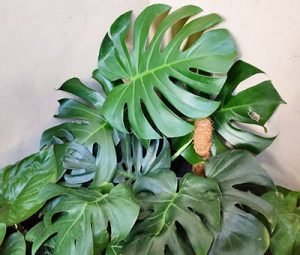 This plant is known for its leaves.
This plant is known for its leaves.
The monster has lavish green and reflexive leaves. This species looks comparative to a palm tree.
Each heart melded leaf that shows up begins as a whole leaf and starts to create its openings.
These leaves will develop while the plant is exceptionally youthful and as it were a matter of several inches tall and even though they don’t create the openings until it develops more.
History of this Monster plant
Monster is part of the “Araceae” Family. This could be a species of flowering plant local to tropical timberlands of southern Mexico, south to Panama. Monster has become a mildly invasive species in Hawaii, Ascension Island, The Society Islands and Seychelles.
The Common name of the Monster plant
The common name of Monster is Monster delicious, Monster, Mexican Breadfruit, Ceriman, Swiss Cheese Plant, Delicious Monster and wrongly.
Tips for planting a Swiss cheese plant?
Where to plant
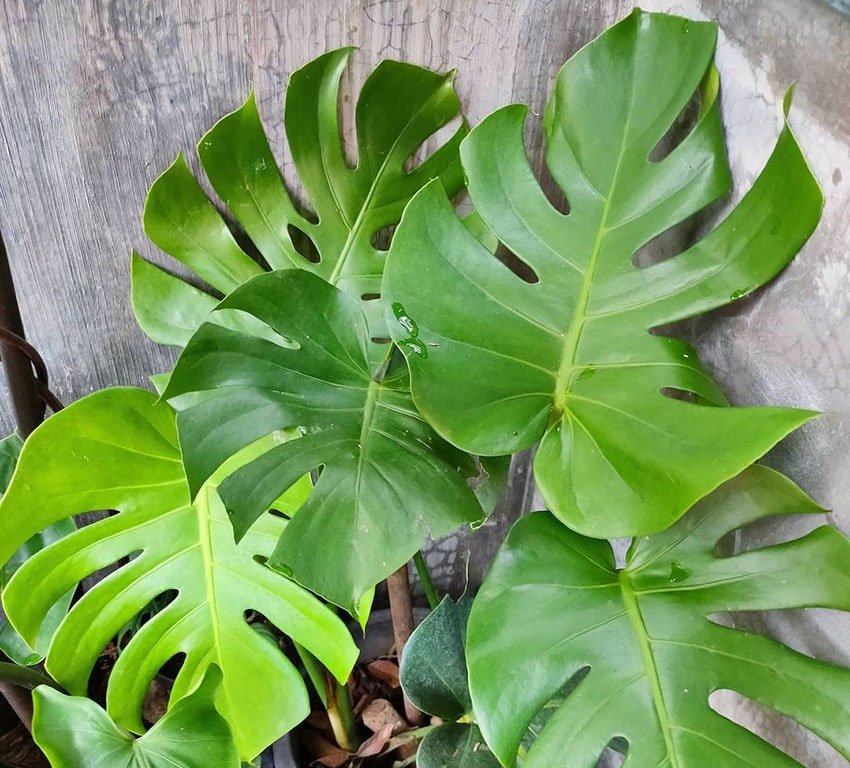
In the house, Put Monster where it can get medium to shinning indirect light. Whereas it is tolerant of lower light conditions, you’ll take note of leggy development as a result. Hence, a spot where it’ll get shinning backhanded light many feet evacuated from a southern, western, or eastern confronting window is ideal.
Outdoor, Monster requires a well-drained area, or a raised bed, in shinning or dappled shade. Water frequently and fertilize month to month. Give a tough bolster since the plant can develop 1 to 2 feet taller each year.
Soil requirement
Monster needs a well-draining preparing blend; a premium preparing blend could be an excellent put to begin. Still, a succulent blend or even chunky orchid blend works incredibly to assist with waste.
Sunlight require by the monster plant
Monster avoids full and direct sunlight because it may burn the leaves. It needs bright, indirect light, so Monster proliferate. In-house, please put it in a bright room a few feet from a window means north or east-facing side or right by a window that doesn’t get much direct sunlight.
Monsters are lovely solid and can survive fair fine in moo light.
How quick will the monster plant develop?

The development of your plant depends on its get to light and water.
In perfect conditions, with shinning roundabout light and steady dampness.
Monsters can develop 1-2 feet per year.
Hight of Monster
These evergreen perennials can reach up to 60 feet or more in tallness in their typical environment.
In your domestic, they can reach around eight feet in stature.
Their leaves alone degree up to 2 feet long.
Care during winter
Within the winter, watering ought to be additional light do not douse the soil, but instep water gently around the pot, and do it as it were almost every two weeks, when the soil has been dry for a whereas.
Move to a hotter spot within the house; in a perfect world, close a window and not fertilize until spring.
How to water the “Swiss cheese plant”?
Water Swiss cheese plant modestly and equally, approximately once a week. Hold up until the soil is reasonably dry, sometimes recently watering again. Once the best 2 to 4 inches of the soil are dry, your plant might utilize a drink.
How long monster plant grow?
These evergreen perennials can reach up to 60 feet or more in tallness in their typical environment. In your domestic, they can reach around eight feet in stature. Their leaves alone degree up to 2 feet long.
Maintenance And Care swiss cheese plant
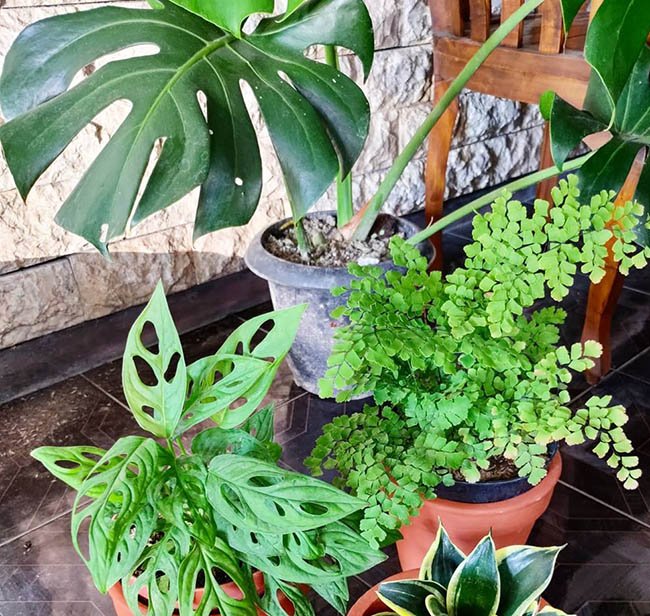
Watering
Water the monster when the top 1 inch of soil feels dry. Water Monster modestly and equitably, almost once a week. Hold up until the soil is decently dry, sometimes recently watering once more. Keep in a decently damp environment.
Protection against pests and diseases to monster plant
Dry air may cause brown tips about the leaf edges. To extend mugginess, fog the leaves routinely or double-pot the plant in a more excellent holder with sodden peat. Gloomy or dusty leaves should be wiped clean with a damp cloth utilizing water as it were and permitted to dry.
Leaf sparkle items may connect to the upper leaf surface or develop clears out to improve the sparkle and see of the leaves. The foremost common issue with monster developed in excellent or low-light conditions is yellowing leaves, with the typical cause being overwatering. To progress the plant’s wellbeing, put it in a brighter spot and diminish the sum of watering.
Paler leaves with straw-coloured patches are more often than not the result of as well much coordinate daylight. Common pests incorporate bugs, coarse bugs and scale, which may control with a bug spray.
Training
The development design of the Swiss cheese plant is much like a pothos – vines that fair keeps getting longer. For pothos, since of its littler in general measure, they can be cleared out to hang off the side of the pot.
Since the monster typical estimate is much bigger, several vines hanging out of the pot would rapidly fill a complete room. In this manner, you ought to attach the vines to a strong trellis so they can develop upwards.
Sunlight need by Monster plant
Swiss cheese plant inclines toward shinning backhanded light. It can survive in lower light conditions, but development may moderate. Keep out of coordinate daylight for amplified periods because it can burn the takes off. Monster Adansonii likes to dry out to around 75% sometimes; recently, it is watered once more.
Pruning
 Such pieces incorporate yellowing or dead leaves, brown or dark ranges on the leaves or stems and range delicate to the touch. For huge vines outside, utilize brightly coloured yarn to distinguish parts to be pruned.
Such pieces incorporate yellowing or dead leaves, brown or dark ranges on the leaves or stems and range delicate to the touch. For huge vines outside, utilize brightly coloured yarn to distinguish parts to be pruned.
Make a level cut over the stem rather than a calculated one near to the parent department as conceivable when expelling entire clears out.
When the portion of a leaf shows signs of wilting or burn harm, evacuate as the harmed area utilizes cuts or hand shears unless you incline toward, for aesthetic reasons, to evacuate the complete leaf.
Expel stems and branches by making a level cut where the stem or department joins with the parent stem-Cutting flush with the parent stem.
Fertilizer
Swiss cheese plant needs fertilizer in spring and summer when monster is developing, fertilize plants month to month with a common reason water-soluble fertilizer such as 20-20-20 connected at the rate of 1 tablespoon per 1 gallon of water for open-air plants and 1/2 teaspoon of water per 2 quarts of water for indoor plants.
Propagation
Stem cuttings more commonly propagate the swiss cheese plant. Cuttings ought to be taken fair after a leaf hub, expelling the bottom-most clears out. At that point, either root the swiss cheese plant cuttings in water for a couple of weeks and transplant them to a pot or mostly bury the cuttings straightforwardly within the soil itself.
How to grow a monster plant in the water?
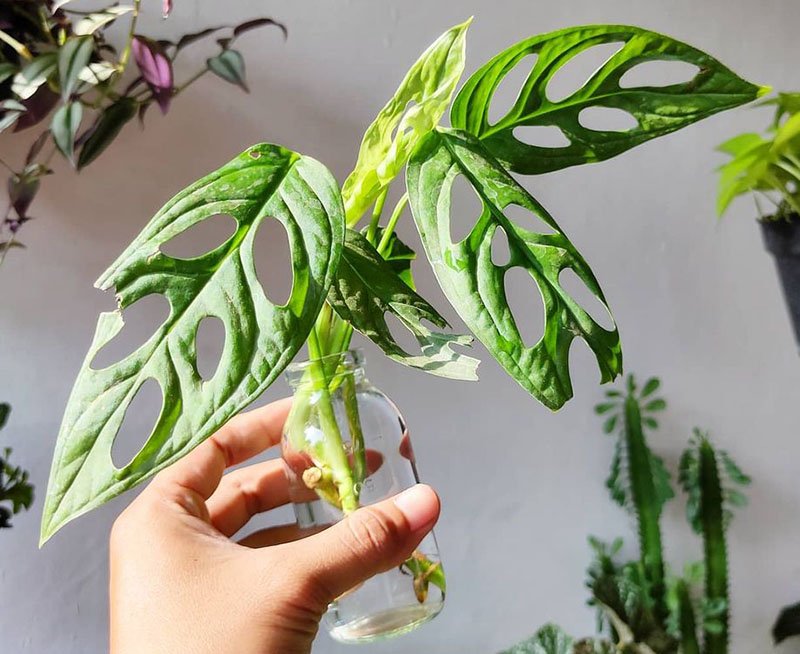
Monster grows in water very quickly. Put the (vase/glass/container/jar) in an area that gets shinning, circuitous daylight. The plant does not like seriously, coordinate sun, and many presentations of it’ll burn the takes off and cause them to turn yellow and drop off the plant. Every 3-5 days or sooner, in case the water gets to be discoloured.
A straightforward holder will permit you to keep a check on the water level and root development. Allow water to reach room temperature sometime recently supplanting the ancient water. Coldwater will stun the plant, and hot water will cook it. Most tap water contains chlorine, so it’s best to utilize bottled or decontaminated water for developing monster.
Add 1/2 or 1 teaspoon of it in 2 gallons of water and utilize it once a month. It can end uproot bound in case the holder is little. Move the plant to a giant holder or prune off a few of the longer ethereal roots with a combination of sharp shears.
Species (types) of Monster plant.
Monster Variegata
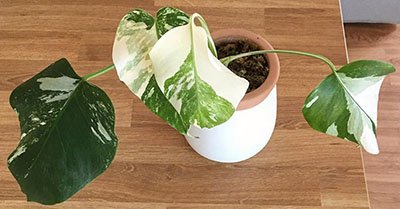
Sometimes these plants indeed see it painted with white paint.
Variegated implies plants that are designed with white or cream color as well as green. These plants tend to be harder to discover and are hence much more costly.
Monster Delicious
This could be a typical assortment of Monster we all know and love, and for the most part, what you’ll discover once you plant shopping. It has those enormous, dazzling holey leaves that are so well known in nurseries and printed domestic stylistic layout right now.
Monster Borsigniana
Delicia’s tend to unsettle, pucker, or frame charming small bumps where the leaf joins the stem, but Borsigniana does not. Borsigniana is additionally smaller and develops speedier than delicious. Develop plants as a rule, shape two flawless columns of holes/slits rather than developing gaps in a more willy-nilly fashion like delicious.
Monster Adansonii
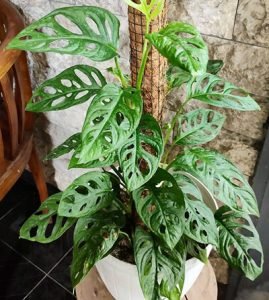
The gaps tend 50% on the leaf. These are reasonably simple to discover, but they’re too mislabelled as monster oblique, but genuine obliquus are amazingly uncommon.
So you’ll be able to be guaranteed that on the off chance that you see this name in a nursery, you’re looking at a Monster adansonii.
Adansonii, too tend to have thicker, rougher leaves than oblique.
Monstera Pinnatipartita
These folks have exceptionally expansive, reflexive leaves but tend to develop openings instead of gaps that go to the edge of the leaf. The leaf stems are hardened, and durable and they have a beautiful emerald green colour.
Monster Dubia
This assortment is characterized by exceptionally little, heart-shaped clears out with both dim and light green coloration. It’s not varied per se, but drawing nearer it. It develops like a vine with shorter stems and leaves that develop closer to anything the plant is climbing.
Monster Siltepecana
This assortment has huge, teardrop-shaped leaves with littler gaps concentrated around the central vein. They are frequently lighter in colour than other monsters and contain both dim and light green tints.
Monster oblique
Monster oblique are near in appearance to Monster adenosine. They develop similarly-shaped gaps interior of the leaves, and the leaves themselves are limit instead of oval or bolt formed.
Related Facts
Monstera deliciosa could be a climbing, blossoming plant that develops in tropical rainforests or other sticky shady zones.
Monsteras have parcels of off-base names.
Monstera natural product exists, and its delicious.
Monstera leaves can’t make additional holes.
The gaps in a Monstera leaf have a function.
Monstera in furniture A Monstera can be an air plant.
Monsteras have muscles.
Questions related to a Monstera plant
1. Is monstera an annual or perennial?
Monstera is an evergreen perennial.
2. How quick does Monstera grow?
The development of your plant depends on its get to light and water. Monsteras can develop 1-2 feet per year in perfect conditions with shinning roundabout light and steady dampness.
3. When you know that your monstera require water?
Drooping leaves, Wrinkled, firm leaves. Yellowing with dry brown spots. Then you realized that Monstera requires water.
4. How do you know on the off chance that your Monstera is healthy?
If your Monstera as it were has one yellowing leaf close the foot, at that point, chances are it’s fair an ancient leaf, and it’s concluded of its expected life. But in case all the takes off are begun to yellow (ordinarily beginning from the tip), and they see limp and pitiful, at that point, you’re likely overwatering.
5. How can I make monstera grow faster?
You can make Monstera grow faster by watering them properly.
Also read:
Philodendron – The Large Genus Of Flowering Plants
Reference
Got some questions? Or some suggestions? That’s why we’ve got a comments section on this blog! You can feel free to leave a comment or two down below, and we’ll get back to you as soon as possible!
We love reading your messages……

